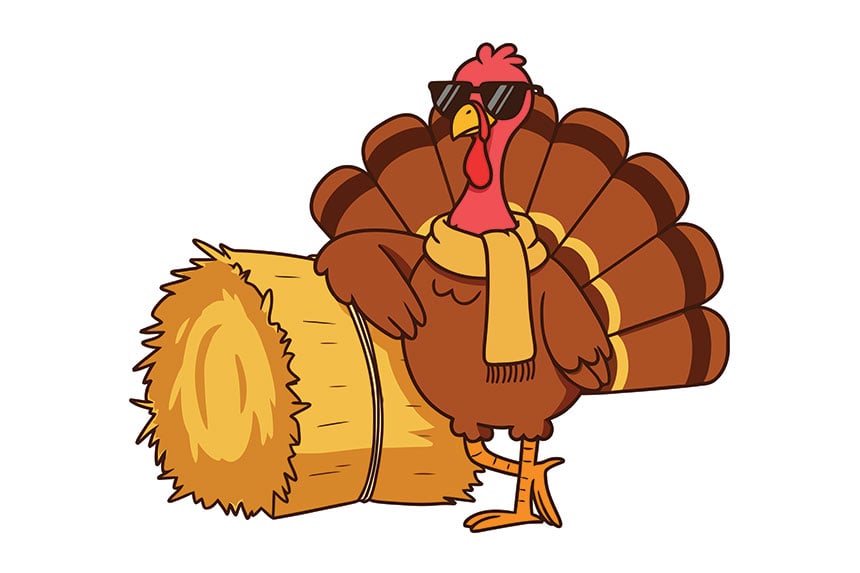Senior managing editor and logophile Andy Hollandbeck reveals the sometimes surprising roots of common English words and phrases. Remember: Etymology tells us where a word comes from, but not what it means today.
In October of 1863, at the height of the Civil War, President Abraham Lincoln invited his fellow U.S. citizens “to set apart and observe the last Thursday of November next, as a day of Thanksgiving and Praise to our beneficent Father who dwelleth in the Heavens.” That proclamation not only created Thanksgiving as a national holiday, but it also led to some lexical innovations in the English language — at least on the left side of the Atlantic Ocean.
In the last hundred years, popular culture has extracted the –sgiving ending of Thanksgiving and turned it into a productive combining form. And while the new words formed with -sgiving always link back in some way to the Thanksgiving holiday, they are used in a wide array of disciplines. Here are just some of the more popular ’sgivings that are out there waiting to be celebrated.
In Politics
For more than 75 years, Thanksgiving was celebrated on the last Thursday of November. However, in 1939, the last day of November was a Thursday. President Franklin Roosevelt decided instead that the holiday should fall on the fourth Thursday of the month; by adding another week between Thanksgiving and Christmas, he hoped to give merchants a bit of a boost by elongating the Christmas shopping season..
The decision wasn’t universally loved. While some people went ahead and shifted their celebratory plans, those who insisted on celebrating on November 30 derisively referred to FDR’s Thanksgiving as Franksgiving. You can read more about it in “The Year of Two Thanksgivings.”
In the end, though, it was hard to argue the benefits, and Thanksgiving was moved to the fourth Thursday of November in 1941; it has been there ever since.
In Cultural Matters
Canada celebrates Thanksgiving on the second Monday in October. To light-heartedly differentiate the holiday of the same name in the United States, some Canadians refer to it as Yanksgiving, from the word Yankee.
On Television
A November 1994 episode of the TV show Friends found the series’ main characters gathering for a Thanksgiving feast. It was the show’s first Thanksgiving episode, and from it arose the concept of Friendsgiving, a Thanksgiving gathering of a chosen family, not necessarily a biological one. For a time, the concept floated along in the collective conscious — along with Friends reruns — without wide adoption.
But in 2011, the word appeared in an advertisement for Bailey’s Irish Cream, and it was heard (and then used) more often. Today, it’s probably the most commonly used of the ’sgiving variants. You can get a pop culture education about it in “Giving Thanks for Friendsgiving.”
Friends wasn’t the only sitcom to give us a ’giving. How I Met Your Mother ran for nine seasons, which included several Thanksgiving episodes. In 2007, we got an episode titled “Slapsgiving,” followed two years later by “Slapsgiving 2: Revenge of the Slap.” Both revolve around a bet in Season 2 in which Marshall (Jason Segel) wins the right to slap Barney (Neil Patrick Harris) five times, at a time of Marshall’s choosing. In “Slapsgiving,” Marshall announces that he will deliver one of the slaps on Thanksgiving night; in “Slapsgiving 2,” Marshall bequeaths one of his slaps to Ted and Robin (Josh Radnor and Cobie Smulders), but it must be delivered before sundown on Thanksgiving. In both instances, Barney’s anxious anticipation of the slap — when will it happen? how hard will it be? will he see it coming? — is worse than the slap itself.
The 2011 Thanksgiving episode of How I Met Your Mother also gave us Blitzgiving, Blitz being the nickname of an old college friend whose bad luck seems to rub off on the rest of the series’ characters. By this point, the ’sgiving form is really starting to get a workout.
With Mind-Altering Behaviors
If the food at your late-November gathering is laced with marijuana, you might be attending Danksgiving or Weedsgiving, both from slang terms for marijuana. A little-known movie called Weedsgiving was released in 2024; in it, two men hoping to celebrate their final Weedsgiving have run out of marijuana. Because all the legal dispensaries are closed for the holiday, they decide they must travel to a state where the substance is still illegal and buy more from a “traditional” drug dealer. High jinks ensue.
Drinksgiving (or, less popularly, Drunksgiving) is also known as Blackout Wednesday; it’s the day before Thanksgiving. Large numbers of young people returning “home” (i.e., to their parent’s home) for the holiday use that Wednesday to visit old friends from school, often enough at bars, where they can “have a few drinks” while they catch up. Drinksgiving is one of the biggest days of the year for bars — after New Year’s and St. Patrick’s Day. It’s also one of the worst nights for drunk driving incidents.
A number of concerts and festivals occurring on the Friday or Saturday after Thanksgiving take the name Dranksgiving, the concept being that if you drank too much at Thanksgiving, this is the cure for your hangover.
In Charity Drives
When I first saw Cranksgiving, I assumed it was a “crystal meth Thanksgiving,” crank being a term for that drug. But the crank in this word refers to a real, physical crank — specifically, one on a bicycle. Cranksgiving began in New York City in 1999 as a charity “race” among bike messengers, and it has now spread to other cities and among bike enthusiasts more generally. In a Cranksgiving race, which usually happens during the weekend after Thanksgiving, participants are given a list of local shops along with a shopping list of mostly food items. “Racers” must bicycle to every store and buy items from the shopping list; at the end, all the items are donated to local charities. There might be a Cranksgiving race in your area this weekend. Find out more at Cranksgiving.org.
No-Shave November is an annual campaign to raise awareness and funds for cancer research and education. Participants are encouraged to donate what they would have spent on haircuts, razors, shaving creams and lotions, and other grooming items during the month to a cancer support charity. No-Shave November culminates in Beardsgiving on November 30: It’s a day to celebrate the luscious facial hair (and leg hair and, yes, pit hair) that was grown in the last month — and perhaps shave it all off.
At Other Times of the Year
Many is a Thanksgiving feast during which someone asks, “Why do we eat like this only once a year?” If you have wondered the same thing, then Fakesgiving is for you. It is simply a Thanksgiving gathering — with all the food, not to mention the family, friends, and sense of gratitude — hosted at some other time of year.
Several online sources name May 30 as the day of Fakesgiving. That could fall in the middle of the week or overlap with Memorial Day weekend, which has its own traditions, so you shouldn’t feel bound to that. There’s no reason you can’t just pick your own day, declare it Fakesgiving, and start thawing another turkey.
Happy Thanksgiving — or whatever ’sgiving you celebrate — from all of us here at The Saturday Evening Post!
Become a Saturday Evening Post member and enjoy unlimited access. Subscribe now




Comments
I am taking in substantial income two Hundred$ doInline from my PC.[884] A month ago I GOT check of almost $31k, this online work is basic and direct, don’t need to go OFFICE, Its home online activity….
learn more in my name